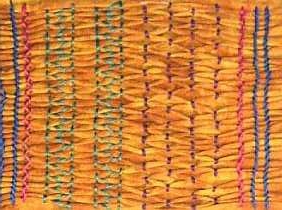Pleats, Tucks & Gathers
PleatingThere are four kinds of pleats, flat pleats, projecting pleats, accordion pleats and wrinkled pleating. Each of these is briefly described below. Flat pleatsThese are parallel folds lifted from the surface of the fabric and laid down to the side. They include knife pleats, box pleats and set in pleats, all are secured with stitch at the top and released below. Projecting pleatsThese are folds lifted from the surface of the fabric and arranged so that they stand out from the fabric itself. They include pinch pleats, organ pleats and cartridge pleats. Accordion pleatsThese are made by folding fabric alternately in and out creating projecting pleats. This is the kind or pleating used for smocking and can be performed by hand, or mechanically on a smocking pleater. Wrinkled pleatingThis consists of irregular ridges made by securing damp, bunched fabric and leaving it to dry. It includes broomstick pleating where the fabric is rolled around a cylinder, when unwrapped, the folds all lie in one direction. Contortion pleating is where the fabric is twisted into a rope, coiled and knotted. When dry the folds lie in all directions. The sample on the right shows flat and accordion pleats on a variety of white fabrics from felt to habotai silk. |

|
TucksTucks reduce fabric measurements in one or both directions. They include, standard tucks, curved tucks, shell tucks, and slashed tucks. Standard tucksThese are parallel folds of fabric held by stitching from one end to the other. They include pin tucks, centred tucks, which have two folds made by centring each tuck over its seam and tapered tucks which have straight seams which are stitched obliquely to the fold. The easiest method of sewing pin tucks is using a twin needle with the top tension slightly tightened. The tighter the top tension and the thinner the fabric, the more raised the tuck will be. For neat even tucks, always start by stitching the tuck on the extreme right and always stitch in the same direction (from top to bottom). The sample on the right show a variety of standard tucks, including cross tucking and double centred tucks, slashed tucks, including sharks teeth and fringed tucks worked on a variety of white fabrics including muslin and polyester. Curved tucksThese follow a curving line often parallel to the curved line of the bottom of the fabric. Slashed tucksThese include sharks teeth tucks where the fabric is slashed more than twice and then folded under on either side of the cuts creating points and snip-fringed tucks where the tuck is cut into loops or along the length of the tuck to form a fringe. |

|
GathersGathering can be done, by hand, by machine, automatically, with elastic and through channels. Gathering by hand and machine involves stitching across the edge of the fabric and pulling on the loose thread to draw up the fabric into mini-folds. The density of the mini-folds, in combination with the stitch length determines the fullness. Hand gathering is done on one or more rows of running stitches, the more rows of stitches the deeper the gathers produced. When the rows of stitching are parallel and identically spaced the gathers look like fine pleats. Machine gathering is faster than hand gathering and can be done using a straight stitch with the top tension loosened and the fabric gathered onto the bobbin thread. Alternatively, zigzag gathering will withstand the strain of long lengths or heavier fabric and is done by encasing the gathering cord under one or more rows of zigzag stitch. Automatic gathering is performed while sewing rather that arranging the fabric afterwards. It requires the use of either a gathering foot or a more complicated ruffler. Both lock an extra piece of fabric into the stitches as sewing is done. Elastic gathering can be done by straight stitching with elastic on the bobbin this gives a soft gather, a fuller gather can be achieved by zigzagging over cord elastic which is stretched during stitching. Channel gathering is performed by either stitching a casing through which a length of cord, ribbon, rod etc. is placed, or by creating loops, holes or slots through which the gathering element is woven. The sample on the right was created using hand and machine gathering on a variety of white fabrics ranging from silk chiffon to heavy weight calico. |

|
SmockingPleating machines have gears that mesh together when turned, and a long, straight row of needles that which thread through the pleats formed by the gears. When the needles fill up with pleats, they are pushed onto the thread. The sample on the left right shows a piece of fabric gathered on a pleating machine. Using a pleater gives a really even piece to smock on and is also considerably faster than pleating by hand. The sample on the right has been worked on hand gathered cotton with stranded cotton. It shows samples of stem stitch, cable stitch, honeycomb stitch and chevron stitch. 

|
|
« back to Manipulated Techniques page | « back to City & Guilds page | ^ top